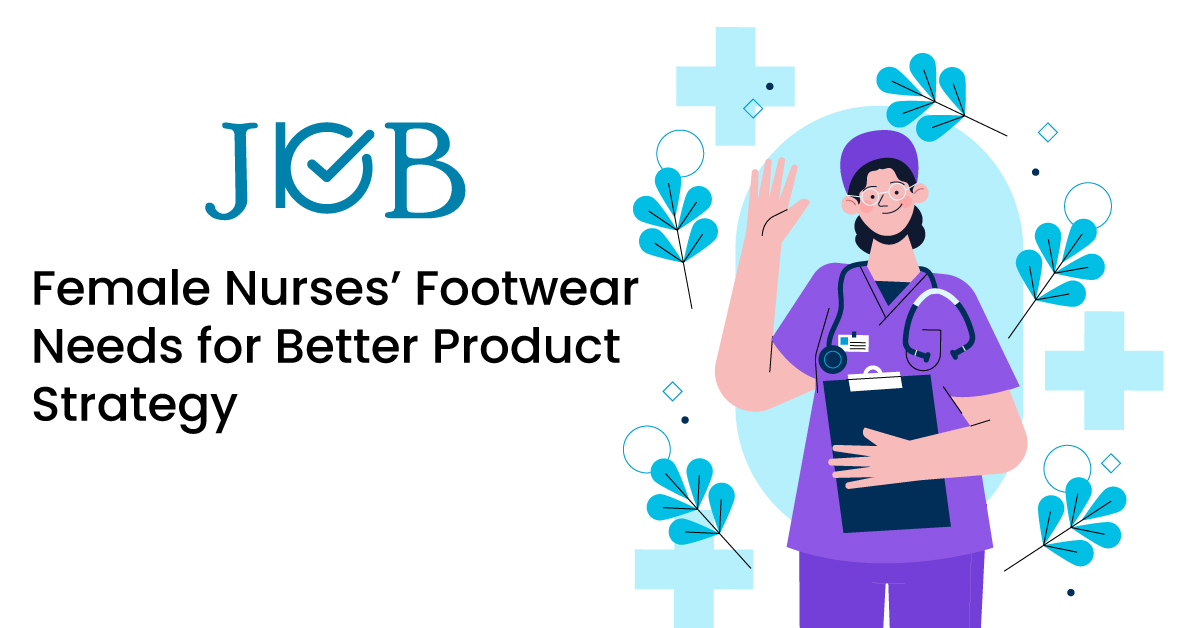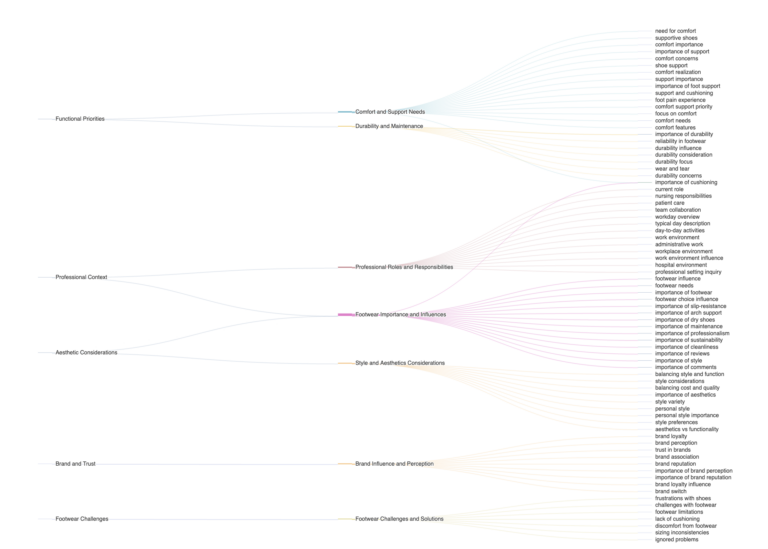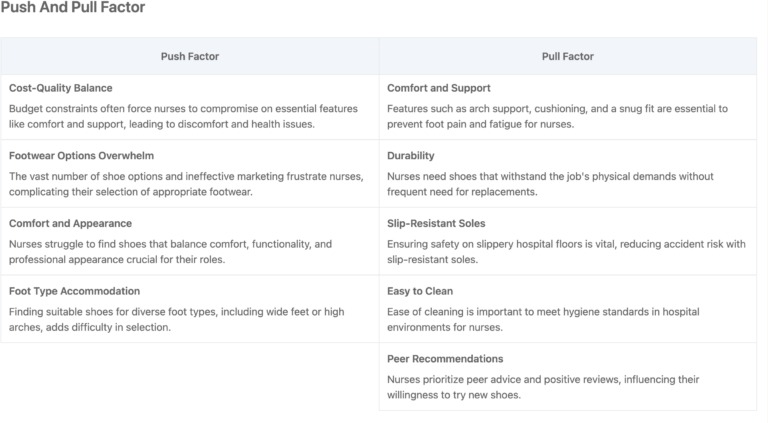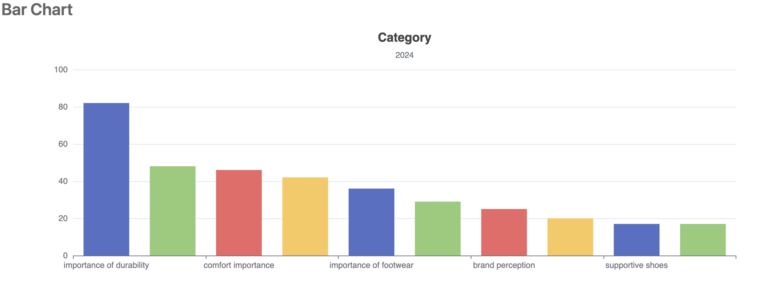Case Study
Research
Impact Study
AI-Powered Insights into Female Nurses’ Footwear Needs for Better Product Strategy

Executive Summary
This case study explores AI-powered insights into female nurses’ footwear needs. It highlights their demand for comfort, support, and durability during extended work hours, emphasizing their demand for comfort, support, and durability to maintain physical well-being and job performance.
Inadequate footwear contributes to discomfort, foot fatigue, and potential health issues, prompting nurses to seek alternatives. Financial constraints often force compromises on quality, but slip-resistant and easily cleanable shoes remain non-negotiable for safety and hygiene in hospital environments.
Poor footwear choices contribute to discomfort, foot fatigue, and potential health risks, making AI-powered insights essential for designing effective solutions. Financial constraints often force nurses to compromise on quality, yet slip-resistant and easily cleanable shoes remain non-negotiable for safety and hygiene.
To address these needs, the study highlights the importance of designing footwear that balances cost with essential features such as durability and comfort. Incorporating peer recommendations, customizable support options, and professional yet functional styles can cater to this audience’s preferences. By aligning product attributes with their core requirements, brands can improve nurses’ job satisfaction and performance while addressing safety and aesthetic considerations.
Background Context
Female nurses often face physically demanding work environments that require long hours of standing, walking, and performing tasks under high-pressure conditions. These factors place significant strain on their physical well-being, making footwear a critical component of their daily comfort and job performance. However, many existing footwear options fail to provide the necessary support, durability, and comfort, leading to issues such as foot fatigue, discomfort, and long-term health concerns.
Recognizing this challenge, Qualz.ai, in collaboration with JobsToBeOk.org, conducted a comprehensive study to understand female nurses’ specific needs and preferences when selecting footwear. The study used AI-driven qualitative analysis to identify the “Jobs to Be Done” that motivate these professionals to purchase new shoes. By analyzing their pain points, expectations, and decision-making processes, the study provides actionable insights to guide the development of footwear solutions that not only meet but exceed their needs, ultimately improving both their job satisfaction and overall performance.
Literature Review
1. Footwear Design and Biomechanics Evaluation for Clinical Nurses.
Recent studies have highlighted the significant prevalence of work-related musculoskeletal disorders (WRMDs) among nursing professionals, with particular emphasis on lower limb discomfort due to prolonged standing and walking. Pan and Zhu (2023) conducted comprehensive research focusing on footwear design and biomechanics evaluation for clinical nurses, identifying that nearly 80% of adults experience lower back pain (LBP) in their lifetime, with nurses being 2.5 times more likely to suffer from LBP compared to other professions. Their study emphasized the critical need for specialized footwear design that considers both biomechanical requirements and occupational demands of nursing professionals.
The research methodology employed by Pan and Zhu (2023) incorporated a three-stage approach, combining field observations, biomechanical testing, and experimental evaluations. Their findings revealed that comfortable clinical care shoes should feature specific design elements, including arch support, three-dimensional vertical insoles, and heel heights below 5cm. The study demonstrated that shoes with 2.5cm EVA outsoles produced lower heel pressure compared to those with rubber soles and 5cm heel height, suggesting that both shock-absorbing materials and heel height are crucial factors in reducing plantar pressure and vertical impact force. These design considerations were found to significantly impact the reduction of plantar pressure distribution and ground impact while increasing ankle flexibility.
2. The use of the ‘Job to Be Done’ methodology to identify value co-creation opportunities.
The study by Ribeiro, Monteiro, and Luttembarck (2018) explores the application of the “Jobs to Be Done” (JTBD) methodology to identify value co-creation opportunities within the framework of Service-Dominant Logic (SDL). This research underscores the pivotal shift in marketing approaches from traditional Product-Dominant Logic to SDL, which emphasizes interactive value co-creation between businesses and their customers. The JTBD methodology, particularly through the Outcome-Driven Innovation (ODI) approach, enables businesses to identify critical customer problems (“jobs”) and devise targeted solutions to enhance co-created value. The authors demonstrate that solving jobs deemed important by customers leads to measurable improvements in organizational performance. They further highlight the moderating role of professional management, showing that organizations with more structured and professionalized governance systems exhibit enhanced value co-creation and performance outcomes (Ribeiro et al., 2018).
The study contributes significantly to both academic and managerial perspectives by integrating practical tools like JTBD with theoretical concepts of SDL. The research provides empirical evidence supporting the hypothesis that addressing customers’ prioritized needs results in greater loyalty, productivity, and profitability. Additionally, the findings affirm that professionalization in management amplifies the impact of solving critical customer jobs on organizational performance, aligning with Grönroos and Voima’s (2013) perspectives on resource integration for value co-creation. The study also sets a foundation for further exploration of contextual variables influencing co-creation processes, such as organizational culture and knowledge management. This integration of SDL theory with JTBD methodology offers a robust framework for understanding and leveraging customer-centric strategies in value creation (Ribeiro et al., 2018).
3. A Comprehensive Exploration of Jobs to Be Done Interviews.
The study by Özal and Münch (2024) provides a comprehensive exploration of the “Jobs to Be Done” (JTBD) framework, focusing on the practical application of JTBD interviews for uncovering customer needs in software product development. The authors highlight the paradigm shift brought by the JTBD framework, which transitions product development from a feature-centric to a customer-centric approach. JTBD interviews allow businesses to identify customers’ underlying motivations and challenges by understanding the “jobs” customers aim to accomplish. Key elements such as structured interviews, participant selection, and a focus on customer emotions and contexts are emphasized as critical to successful implementation. Additionally, the study identifies innovative tools like job maps, timelines, and techniques such as open-ended questioning, which provide deeper insights into customer behavior (Özal & Münch, 2024).
The research also identifies significant challenges in conducting JTBD interviews, including participant recruitment, managing complex or sensitive topics, and addressing technical or logistical issues during interviews. Despite these challenges, the study underscores the potential of JTBD interviews to enhance product development by aligning solutions with actual customer needs. The insights gained through JTBD interviews not only foster innovative product design but also improve resource allocation, minimize development risks, and strengthen competitive positioning. By integrating theoretical and practical aspects of JTBD, the study offers valuable guidance for organizations seeking to adopt customer-centric methodologies in their product development strategies (Özal & Münch, 2024).
Methodology
The study was conducted collaboratively by JobsToBeOk.org and Qualz.ai to investigate the specific footwear needs of female nurses working extended hours. A systematic approach was employed to ensure a comprehensive understanding of the target audience and to generate actionable insights. The process began with the development of detailed personas representing female nurses. These personas incorporated diverse demographic and occupational characteristics, reflecting the varying work environments and personal preferences within the target population. These personas served as the foundation for in-depth interviews conducted with participants, focusing on their experiences, challenges, and expectations related to footwear. The qualitative data collected through these interviews provided rich insights into the underlying factors influencing footwear choices.
The interview transcripts were analyzed using thematic analysis to identify recurring themes and patterns. Advanced AI tools provided by Qualz.ai were leveraged to enhance the accuracy and granularity of the analysis, enabling the extraction of meaningful insights. These findings were visualized through an interactive dashboard, which showcased key insights, such as common themes, influencing factors, and decision-making dynamics. This visualization facilitated a deeper understanding of the data and allowed stakeholders to interact with the findings effectively.
Additionally, a knowledge graph was constructed to represent the relationships between identified themes and insights. Microsoft’s GraphRAG (Graphs + Retrieval Augmented Generation) methodology was utilized to integrate text extraction, network analysis, and language model summarization into a cohesive system. This advanced technique enabled the creation of a comprehensive and insightful representation of the data.
Findings and Insights
Through a comprehensive analysis of the Jobs-to-be-Done interviews with female nurses, several significant patterns and themes emerged regarding their footwear needs and decision-making processes. The findings reveal complex interrelationships between functional requirements, professional demands, and personal preferences.
Thematic Structure of Footwear Decision-Making

Fig 1.1: Sankey chart illustrating themes, their categories and respective codes
The qualitative analysis, visualized through the Sankey diagram, illuminates six fundamental themes that govern nurses’ footwear choices: Functional Priorities, Professional Context, Aesthetic Considerations, Brand and Trust, Footwear Challenges, and Comfort and Support Needs. These themes interweave throughout the nurses’ narratives, demonstrating that their footwear decisions are not simply about comfort or functionality in isolation, but rather about satisfying multiple competing demands simultaneously.
Motivational Dynamics in Footwear Selection

Fig 1.2: Push factors vs Pull factors of female nurses
The research revealed a sophisticated interplay of push and pull factors that influence nurses’ decisions to seek new footwear solutions. On the push side, nurses frequently encounter challenges with cost-quality trade-offs in their current footwear. Budget constraints often force compromises on essential features, leading to discomfort and potential health issues. The market’s vast array of options, combined with ineffective marketing approaches, creates decision paralysis rather than informed choice. Additionally, nurses struggle to find footwear that successfully balances professional appearance with functional comfort, a challenge further complicated by the diverse foot support needs of individual practitioners.
Conversely, several clear pull factors attract nurses toward specific footwear solutions. The primary attraction lies in comprehensive comfort and support features, particularly arch support, cushioning, and proper fit, which are essential for preventing foot pain and fatigue during extended shifts. Durability emerges as another crucial pull factor, as nurses seek footwear capable of withstanding the intense physical demands of their profession without requiring frequent replacement. Safety considerations, specifically slip-resistant soles, play a vital role in their decision-making, given the potentially hazardous conditions of hospital environments. The need for easily cleanable footwear also stands out as a significant pull factor, reflecting the strict hygiene standards of healthcare settings.
Quantitative Priority Analysis

Fig 1.3: Bar graph showing the most mentioned codes during the interviews
The frequency analysis of interview codes, represented in the bar chart, provides quantitative validation of these qualitative findings. Durability emerged as the most frequently cited concern, appearing in approximately 80% of discussions. This was followed by comfort-related considerations at 45% and general footwear importance at 35%. Brand perception and specific supportive features, while significant, appeared less frequently in the discussions at 25% and 15% respectively.
Synthesis of Core Insights
The primary “job” that nurses hire shoes to accomplish extends beyond basic functionality to encompass a complex set of professional and personal requirements. The research reveals a significant gap between market offerings and nurse needs, particularly in the realm of cost-effective solutions that don’t compromise on essential features. The professional healthcare environment imposes unique demands on footwear choices, requiring solutions that simultaneously address safety, hygiene, and professional appearance standards.
The decision-making process is further complicated by the interplay between individual financial constraints and the overwhelming variety of available options. This complexity is exacerbated by the challenge of finding appropriate footwear that accommodates various foot types while meeting all professional requirements. These findings suggest a clear opportunity for footwear manufacturers to better align their products with the multifaceted needs of nursing professionals, potentially through more targeted design and marketing approaches that address the specific challenges identified in this research.
The knowledge graph, in conjunction with the thematic analysis, formed the basis for a detailed report. This report provided a nuanced understanding of the footwear needs of female nurses, offering strategic recommendations for product development and marketing. By adopting this structured and innovative approach, the study delivered robust insights to inform targeted solutions aimed at improving the comfort, safety, and performance of the target audience.
Recommendations
Based on the comprehensive analysis of nurse interviews and identified needs, the following recommendations address key opportunities for improving nursing footwear solutions:
Product Development and Design
The research indicates a critical need for purpose-built nursing footwear that prioritizes both function and comfort. Manufacturers should focus on developing shoes with advanced cushioning technologies and enhanced arch support systems specifically engineered for extended shifts. The incorporation of customizable features is paramount, including adjustable arch supports, variable width options, and interchangeable insoles to accommodate diverse foot types and personal preferences. Design priorities should emphasize immediate comfort without requiring break-in periods, achieved through careful material selection and ergonomic design principles. Durability must be enhanced through the use of high-quality, wear-resistant materials that can withstand the demands of the healthcare environment. Essential features should include:
- Slip-resistant soles are designed specifically for hospital floor conditions.
- Breathable materials that maintain hygiene during long shifts.
- Easily cleanable surfaces that meet hospital sanitation requirements.
- Lightweight construction to reduce fatigue during extended wear.
Marketing and Communication Strategy
Marketing approaches should be fundamentally restructured to address the identified decision-making challenges faced by nurses. Communications should prioritize transparency and evidence-based claims about comfort, support, and durability features. Specific recommendations include:
- Authentic representation in marketing campaigns is achieved by featuring real nurses and genuine testimonials to create relatable and credible product presentations.
- Addressing trust issues identified in research involves moving away from generic advertising toward authentic storytelling.
- Comprehensive educational materials should explain technical features and benefits in the nursing context to help nurses make informed decisions.
- Providing educational content helps nurses navigate overwhelming options in the market with clarity and confidence.
- Peer validation can be promoted by establishing platforms for nurses to share their experiences and reviews.
- Leveraging peer recommendations acknowledges the significant influence of colleagues on nurses’ purchase decisions.
Customer Experience Enhancement
To address the identified gap between product expectations and real-world performance, implement the following customer experience improvements:
- Trial programs should offer professional trial periods for nurses to evaluate footwear in their actual work environment, reducing purchase risk.
- Allowing nurses to test products in real-life scenarios builds confidence in their product selection.
- Customization services should include in-store and online fitting options to help nurses find footwear suited to their specific needs, foot type, and working conditions.
- Tailored fitting services address individual preferences and ensure optimal comfort and functionality.
- Guarantee programs should address durability and comfort concerns identified in the research, showcasing a commitment to product performance.
- Comprehensive guarantees demonstrate confidence in the quality and reliability of the footwear offered.
Price-Value Optimization
Address the crucial cost-quality balance by:
- Developing tiered product lines that maintain essential features at different price points.
- Creating educational materials that demonstrate the long-term cost benefits of investing in quality footwear.
- Implementing flexible payment options to make higher-quality options more accessible.
Continuous Improvement Process
Establish a systematic approach to product enhancement through:
- Regular collection and integration of nurse feedback into the design process.
- Ongoing research into emerging materials and technologies that could improve comfort and durability.
- Development of wear-testing programs with nursing professionals to validate product improvements.
These recommendations aim to address the core challenges identified in the research while creating sustainable competitive advantages for manufacturers who successfully implement them. The focus on evidence-based design, authentic marketing, and customer-centric experiences directly responds to the primary concerns expressed by nursing professionals in the study.
Implementation Considerations
The successful execution of the recommended changes requires a structured approach to implementation, considering both immediate actions and long-term sustainability:
Timeline and Phasing
Implementation should follow a phased approach, beginning with features identified as the highest priority in the research. Initial focus should be on enhancing core comfort and support features, followed by the introduction of customization options and advanced technological integrations. This staged implementation allows for proper testing and refinement at each phase while managing resource allocation effectively.
Resource Requirements
Product development initiatives will require significant investment in research and development, particularly for advanced cushioning technologies and customizable support systems. Marketing strategy adjustments necessitate the allocation of resources for creating authentic content featuring real nursing professionals and developing educational materials. Additionally, the establishment of trial programs and guarantee systems requires operational infrastructure and customer service support.
Measurement and Monitoring
Success metrics should focus on quantifiable outcomes including:
- Reduction in reported foot pain and fatigue among users
- Decrease in the frequency of footwear replacement
- Improvement in customer satisfaction scores
- Market share growth in the nursing footwear segment
- Return rates and warranty claims
Regular monitoring of these metrics will enable timely adjustments to implementation strategies and identify areas requiring additional attention or resource allocation.
Conclusion
This Jobs-to-be-Done research has revealed critical insights into the footwear needs of female nurses, highlighting significant gaps between current market offerings and actual user requirements. The findings demonstrate that nurses’ footwear selection is driven by a complex interplay of functional, professional, and personal factors, with durability and comfort emerging as paramount concerns. The recommended interventions address these needs through targeted product improvements, authentic marketing approaches, and enhanced customer experience initiatives. Success in implementing these recommendations requires careful consideration of resource allocation, timeline management, and continuous performance monitoring.
By addressing the identified challenges and opportunities, manufacturers can better serve the nursing community while establishing stronger market positions. Most importantly, improved nursing footwear solutions will contribute to the well-being and job performance of healthcare professionals who play a vital role in patient care delivery. The path forward is clear: developing purpose-built nursing footwear that truly meets the multifaceted needs of healthcare professionals while maintaining accessibility and affordability. This balanced approach will not only benefit manufacturers and nurses but ultimately contribute to enhanced healthcare delivery through improved provider comfort and performance.
References
- Özal, E., & Münch, J. (2024). Unveiling Customer Needs: A Comprehensive Exploration of Jobs to Be Done Interviews. Proceedings of the International Workshop on Software and Innovation-Based Research (IWSIB 2024), April 2024, Lisbon, Portugal. https://doi.org/10.1145/3643690.3648240
- Pan, H. and Zhu, H. (2023) ‘Footwear Design and Biomechanics Evaluation for Clinical Nurses’, Frontiers in Sustainable Development, 3(9), pp. 61-67. https://doi.org/10.54691/fsd.v3i9.5602
- Ribeiro, Á. H. P., Monteiro, P. R. R., & Luttembarck, L. (2018). The use of the ‘Job to Be Done’ methodology to identify value co-creation opportunities in the context of the Service-Dominant Logic. Brazilian Business Review, 16(1), 38–54. https://doi.org/10.15728/bbr.2019.16.1.3

